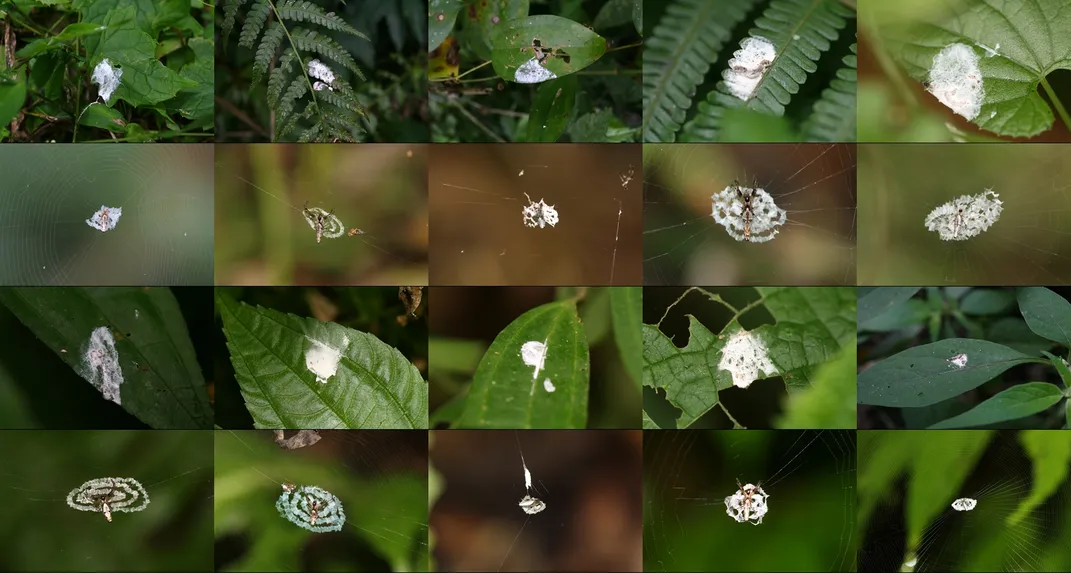This Spider Web Was Deliberately Spun to Look Like Bird Poop
It’s not artistic license. The arachnid avoids predators by masquerading as bird droppings, say scientists
/https://tf-cmsv2-smithsonianmag-media.s3.amazonaws.com/filer/bb/17/bb179009-40c1-416c-80e0-a88c8f378cff/s029.jpg)
Deep in the forests of Southeast Asia lives a silver-colored orb-weaving spider that decorates its web with a silky spiral pattern and bits of dead leaves. This isn’t just to make the web a bit more festive, though. Some scientists think that this arachnid is just pretending to be poop—bird poop specifically.
In a paper published today in Scientific Reports, a team of researchers from Tunghai University and the Endemic Species Research Institute in Taiwan argue that Cyclosa ginnaga spiders’ body color and web designs are part of a strategy to masquerade as bird droppings and cut its chances of dying in a predator attack.
“We provide empirical evidence for the first time that bird dropping masquerading can effectively reduce the predation risk of an organism,” says I-Min Tso, a co-author on the study and an ecologist at Tunghai University in Taiwan.
When it comes to their webs and body coloration, a spider has two key goals: be flashy enough to lure in prey, but don’t draw the attention of predators. It’s hard to achieve both. Different species handle them in different ways, and every tactic has pros and cons.
Cyclosa species typically decorate their webs with all sorts of things—thick silk spirals, prey carcasses, egg sacs, and plant material. One species even constructs a decoy spider out of these materials to confuse predators.
Scientists had previously observed that young C. ginnaga spiders have silvery white body coloration, and often build beautiful spirals on their webs sprinkled with leaf debris. However, it has been unclear whether these structures serve primarily to attract prey or camouflage the bugs from predators. Some have hypothesized that C. ginnaga webs might be attracting prey for the spiders to munch on, and in the forest, decorated webs do appear to lure in more unsuspecting prey.
But something about the appearance of the webs caught the eye of researchers on the Taiwan-based team. “To the naked eye the visual appearance of the spiders on their decorations resembles a bird dropping,” says co-author Sean Blamires, a biologist at Tunghai University. And if it looks like a bird dropping, perhaps it’s supposed to look like a bird dropping.

To test their hypothesis, they first measured webs in the forest outside Wu-Shy-Keng, Taichung, Taiwan, against typical bird droppings in the area. Both were about the same size.
To determine whether the webs reflected the same colors as actual droppings when viewed by predatory wasps, the team collected 10 C. ginnaga spiders in the field and used a spectrometer to measure the wavelengths of light emitted by the spider bodies, decoration silk, and bird dropping samples against the backdrop of the forest understory. A computer program that mimics the sensory eye cells of bees told the team whether or not wasps, the spider’s primary predator and one that has similar eye structures to bees, could pick up on differences between the spider, the web, and the bird droppings. All were indistinguishable. When the scientists blacked out the spiders bodies and/or web décor with ink or powder, the program indicated wasps would be able to see their prey.
Testing this with a computer program is one thing, but the researchers wanted to see if web coloration and body design paid off in the forest for these spiders. So every day for 13 days, the authors set up video cameras in front of 12 C. ginnaga webs and videotaped the action on each web. Again, they covered some spider’s bodies with black ink, concealed other spiders’ web decorations with black powder, concealed both in some cases, and left others untouched. At the beginning of each day of filming, they measured the size of the spider, the size of the web decoration, and the size of nearby bird droppings.
In both the visual tests and observations in the wild, predators could more readily see darkened spiders on normal webs, as well as normal spiders against dark webs. Wasps were much more likely to attack a web if the spider’s body or decorations were stood out thanks to powder and ink, while wasps couldn’t distinguish unaltered spiders from their unaltered backdrops. Wasps also went after dark spiders on dark webs, indicating that similarly colored spiders and webs weren't enough to confuse the predators—for that, spiders and webs both needed to blend in to the background of the forest.
In short: “When the color signal of decoration silk is altered the predator attack rate increased significantly,” says Tso.
Obviously, a strategy that allows spiders to avoid broadcasting to predators but still trap prey would come in handy evolutionarily. The researchers will have to further investigate how wasps respond to bird droppings alone and whether they treat webs exactly like bird droppings to confirm if the spider’s coloring and behavior truly fits the bill for a biological masquerade—when an animal’s body color and shape mimic an inanimate object. It’s hard to assess the psychology of a wasp, notes Tso. But, his team is going to try.
Cyclosa spiders aren’t the only organisms that masquerade as things: Lithops plants look like rocks, while leafy sea dragons (Phyllopteryx eques) resemble seaweed. There are tons of examples in insects as well: stick and leaf insects resemble, well, sticks and leaves, and a species of crab spider (Phrynarachne decipiens) looks strikingly like bird poop, too. Studies have even shown that birds can’t distinguish twig-mimicking caterpillars from a pile of sticks. But, up until now, it’s been unclear whether these masks translate to an actual anti-predator benefit for the spiders.
C. ginnaga’s bird-dropping costume takes camouflage to a whole new level. Poop, one could say, is their signature color.
/https://tf-cmsv2-smithsonianmag-media.s3.amazonaws.com/accounts/headshot/Screen_Shot_2014-01-27_at_12.05.16_PM.png)
/https://tf-cmsv2-smithsonianmag-media.s3.amazonaws.com/accounts/headshot/Screen_Shot_2014-01-27_at_12.05.16_PM.png)